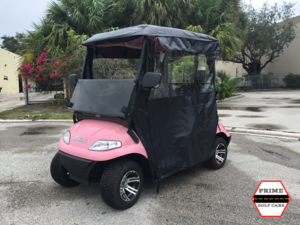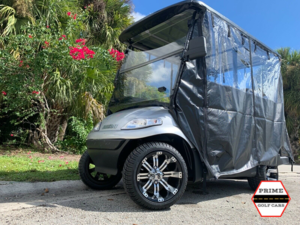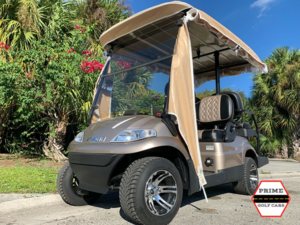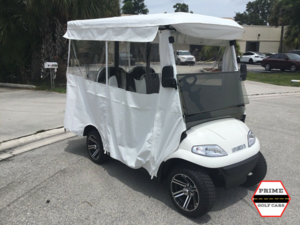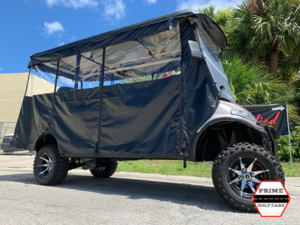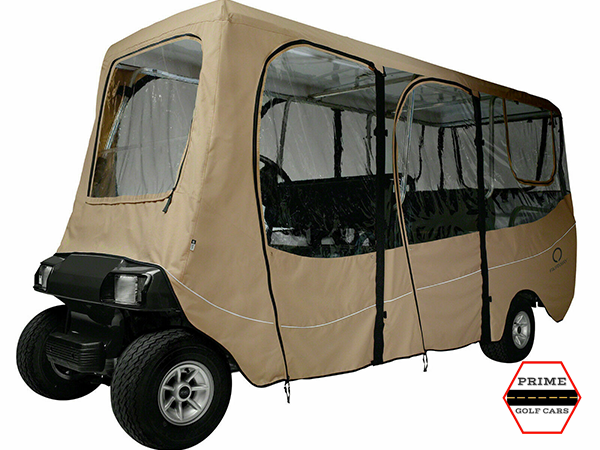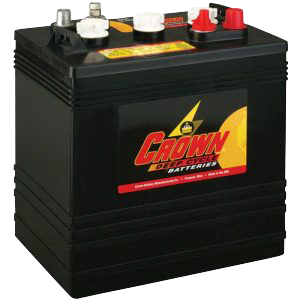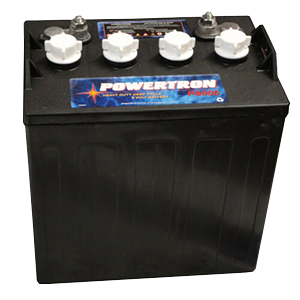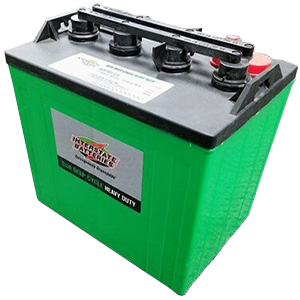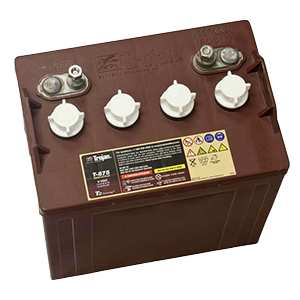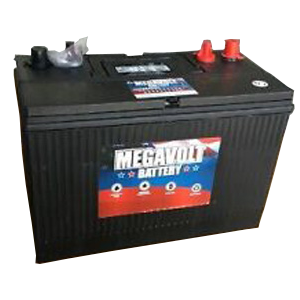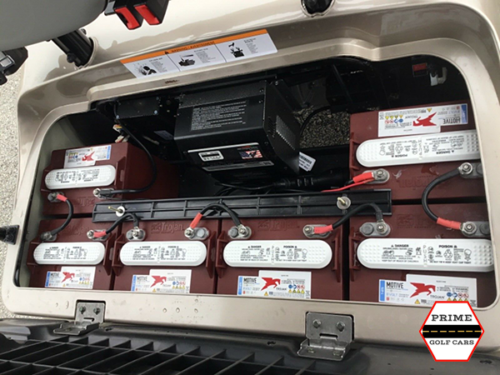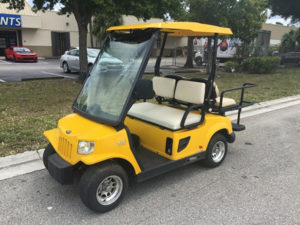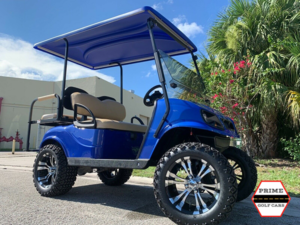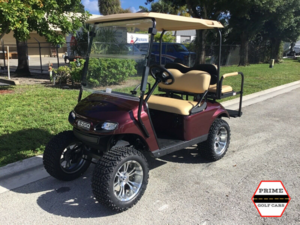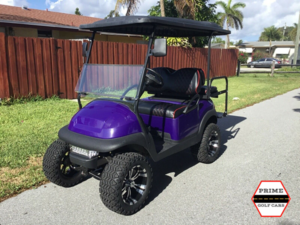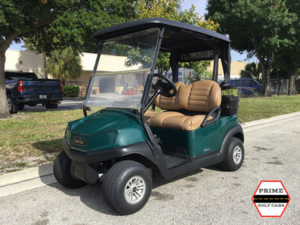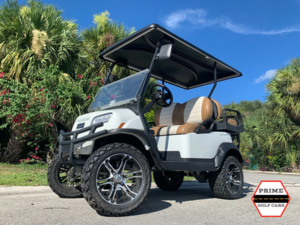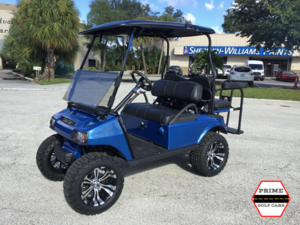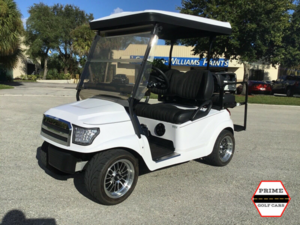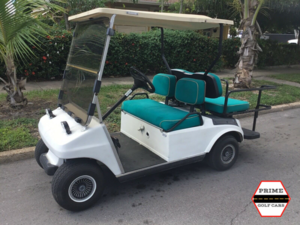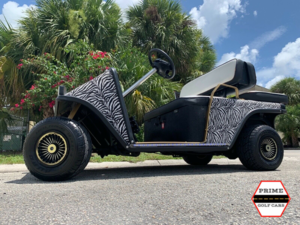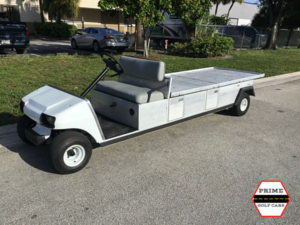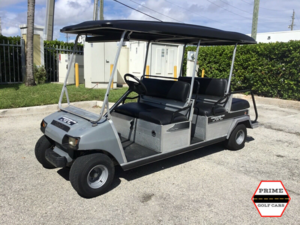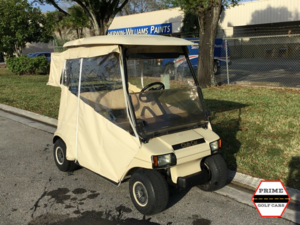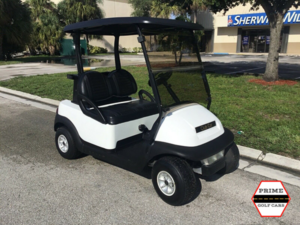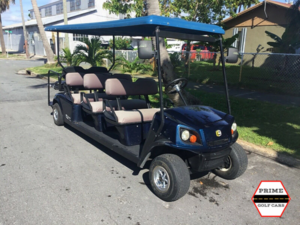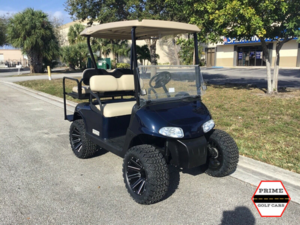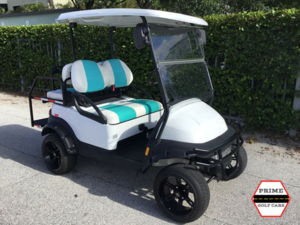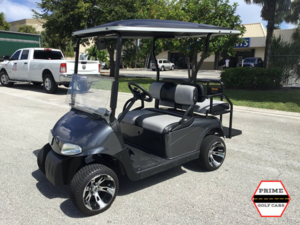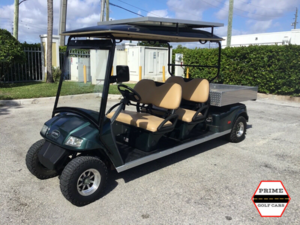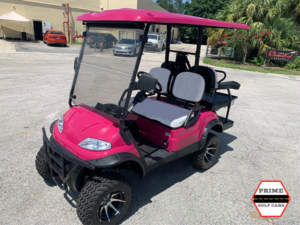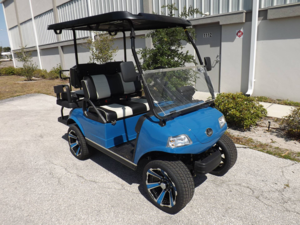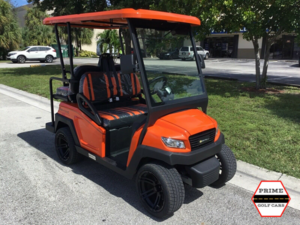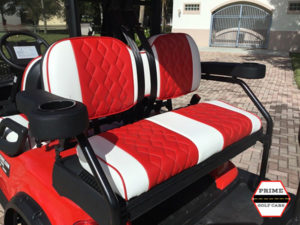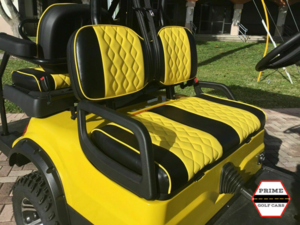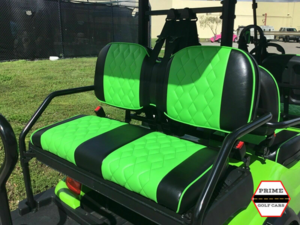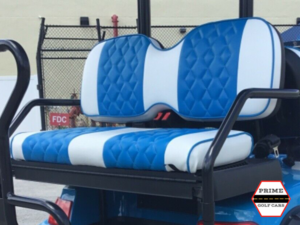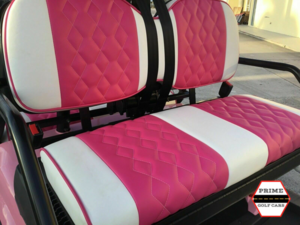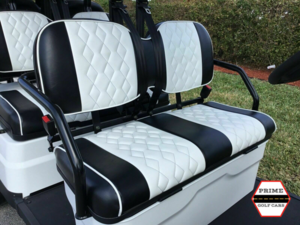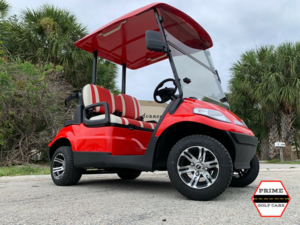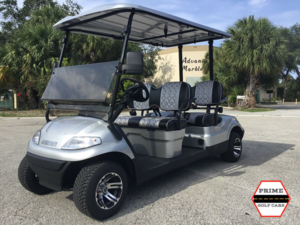What’s the difference between a golf cart and an LSV?
 Often times, we use the terms interchangeably, but a golf cart and an LSV are actually two separate vehicles. Low speed vehicles (LSVs) and golf carts can look the same, but the main difference is that LSVs are street legal and have a VIN number. An LSV must have a maximum speed of 24mph in order to be registered as a street legal vehicle, and can be driven on roads with a speed limit of 35mph or less. LSVs also need a variety of safety features in place in order to be street legal, including headlights, tail lights, brake lights, turn signals, a horn, seat belts, a windshield, and side view mirrors.
Often times, we use the terms interchangeably, but a golf cart and an LSV are actually two separate vehicles. Low speed vehicles (LSVs) and golf carts can look the same, but the main difference is that LSVs are street legal and have a VIN number. An LSV must have a maximum speed of 24mph in order to be registered as a street legal vehicle, and can be driven on roads with a speed limit of 35mph or less. LSVs also need a variety of safety features in place in order to be street legal, including headlights, tail lights, brake lights, turn signals, a horn, seat belts, a windshield, and side view mirrors.
Some of our golf carts, such as our Advanced EV 2 passenger non street legal carts, can reach 24mph, but are not made to be street legal. This is the same with our EZGO, Club Car, and Yamaha carts – although some of them can reach up to 20-22mph, they lack the safety features that LSVs come with. However, these carts can be upgraded to include these features, and can even be made to go faster with a speed upgrade. Another requirement for a cart to be an LSV is that it must be electric – gas golf carts are not street legal, which we explain further in our previous golf cart answers blog.
How long do golf cart batteries last?
Depending on the weight on the golf cart and the speed being maintained, generally, lead-acid golf cart batteries can last about 20-25 miles before needing to be charged. Example: 6 adults using a 6 passenger golf cart at its maximum speed of 24mph will need to recharge their golf cart sooner than 2 adults using a 4 passenger golf cart at the same speed. Lithium golf cart batteries, on the other hand, can last up to 60 miles before needing to be recharged, and their recharge time is a lot faster than lead-acid batteries. For more information, read our blog about the benefits of lithium batteries, or visit our golf cart lithium battery website.
In terms of longevity, generally, lead-acid batteries will need to be replaced every few years, while lithium batteries can last up to 10 years.
When and how do you charge a golf cart?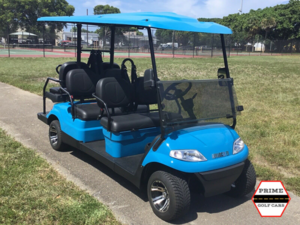
For a standard lead-acid battery system – the most common golf cart battery system -, you’ll want to charge your golf cart once it starts to get down to the 50% area. Advice we give to a lot of our customers is to use the golf cart for the day and plug it in at night and let it recharge overnight. The lower the charge, the longer it takes for the golf cart to fully recharge, and if a lead-acid battery’s charge gets too low, it can take over 12 hours to get back up to 100% charged. In some cases, if the battery becomes too depleted, a regular recharge won’t work, and the battery will have to be supercharged – a service we provide when necessary. When renting a golf cart from Port Saint Lucie Golf Cart Rental, your golf cart will come with a charging cable. One end plugs into the cart, while the plug can be connected to any standard 110 household outlet. Plug the cart into an outside outlet, an outlet in the garage, or run an extension cord out your door from an outlet inside – all methods are sufficient.
Do golf carts have a warranty?
Our Advanced EV golf carts come with a 2 year warranty, while our Evolution golf carts carry a 2 year warranty on the cart itself and a lifetime warranty on the chassis. Our America EV carts also come with a 1 year warranty. Used golf carts do not have a warranty.
What should I look for when buying a golf cart?
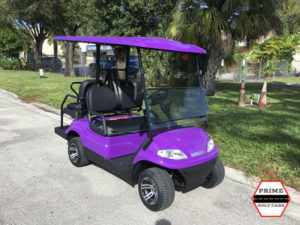 When buying a golf cart, no matter if it’s new or used, you’ll want to check the condition first. Make sure that a new cart’s batteries are also new and that the range is sufficient, and for used carts, keep the age of the (lead-acid) batteries in mind. It’s okay if the batteries are one or two years old, but if they’re older than that, keep in mind that you’ll need to replace them a lot sooner than you would with new or slightly used batteries. If you want a street legal golf cart, the price will increase, and it’ll be much easier to find a new street legal golf cart instead of a used street legal golf cart; used street legal golf carts are very hard to come by. Check for any damages, even on new carts – damage during shipping is rare, but not impossible. Keep the price in mind too – a brand new street legal cart with multiple accessories will have a much higher price than a 10 year old non street legal golf cart. Make sure everything works, especially when buying a used golf cart – just like a car, keep in mind that you may be paying a lower price now, but may have to spend more for future maintenance, whereas a brand new golf cart may be more expensive now, but will last much longer before needing major service.
When buying a golf cart, no matter if it’s new or used, you’ll want to check the condition first. Make sure that a new cart’s batteries are also new and that the range is sufficient, and for used carts, keep the age of the (lead-acid) batteries in mind. It’s okay if the batteries are one or two years old, but if they’re older than that, keep in mind that you’ll need to replace them a lot sooner than you would with new or slightly used batteries. If you want a street legal golf cart, the price will increase, and it’ll be much easier to find a new street legal golf cart instead of a used street legal golf cart; used street legal golf carts are very hard to come by. Check for any damages, even on new carts – damage during shipping is rare, but not impossible. Keep the price in mind too – a brand new street legal cart with multiple accessories will have a much higher price than a 10 year old non street legal golf cart. Make sure everything works, especially when buying a used golf cart – just like a car, keep in mind that you may be paying a lower price now, but may have to spend more for future maintenance, whereas a brand new golf cart may be more expensive now, but will last much longer before needing major service.
In the end, it really depends on what you’re using the golf cart for – for transporting heavy materials for construction sites, a used utility cart will be just fine, while you’ll want a new street legal LSV if you plan on driving it daily on the road.
Where else can you use a golf cart?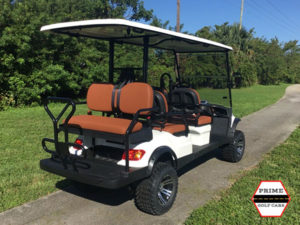
Most of the golf carts we rent out are used for street use rather than on the golf course, though they can be used on both, and in many more places! A lot of people who come down to Florida on vacation rent a golf cart from us because it’s more affordable than a standard car rental. Golf carts can also be used for event transportation – for example, we provide a lot of rentals for weddings, where a host may need to transport guests around the venue -, utility carts can be used for construction sites to carry loads of heavy building materials, and golf carts are also used for campground and resort transportation.
If you have any other questions, we may be able to provide the golf cart answers you need – use our contact form or call to get in touch with us!
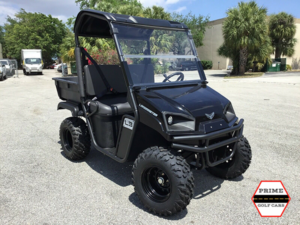
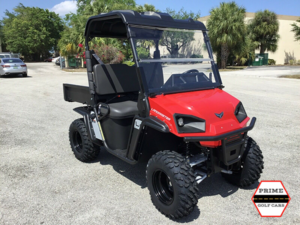
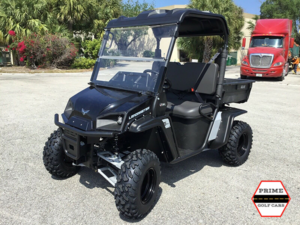
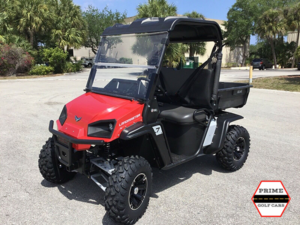
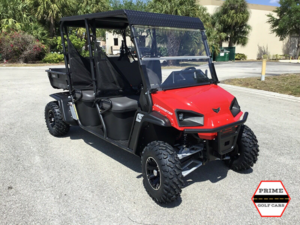
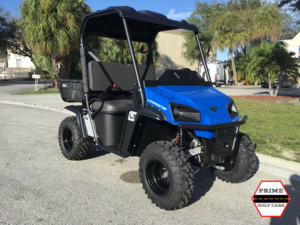 The American Landmaster is a gas-powered utility terrain vehicle (UTV) able to reach a maximum speed of 24mph, fully American made and built from the ground up in Columbia City, Indiana. Each vehicle is four-wheel drive with four-wheel hydraulic disk brakes, built with more than 30 new features in safety, reliability, performance, and design. Along with its own suspension system – the Landmaster ride optimization suspension system (LROSS) -, the Landmaster also features dual rate shocks. This system helps keep the ride smooth even when the bed in the back is fully loaded – also capable of being dumped. Included as well is a caliper-mounted parking brake system, allowing the vehicle to be parked on an incline and locked in place, and when it’s time to disembark, an indicator light reminds the driver to release the parking brake. These vehicles provide over 8 inches of front and rear suspension travel, and stand with an 11 inch ground clearance.
The American Landmaster is a gas-powered utility terrain vehicle (UTV) able to reach a maximum speed of 24mph, fully American made and built from the ground up in Columbia City, Indiana. Each vehicle is four-wheel drive with four-wheel hydraulic disk brakes, built with more than 30 new features in safety, reliability, performance, and design. Along with its own suspension system – the Landmaster ride optimization suspension system (LROSS) -, the Landmaster also features dual rate shocks. This system helps keep the ride smooth even when the bed in the back is fully loaded – also capable of being dumped. Included as well is a caliper-mounted parking brake system, allowing the vehicle to be parked on an incline and locked in place, and when it’s time to disembark, an indicator light reminds the driver to release the parking brake. These vehicles provide over 8 inches of front and rear suspension travel, and stand with an 11 inch ground clearance.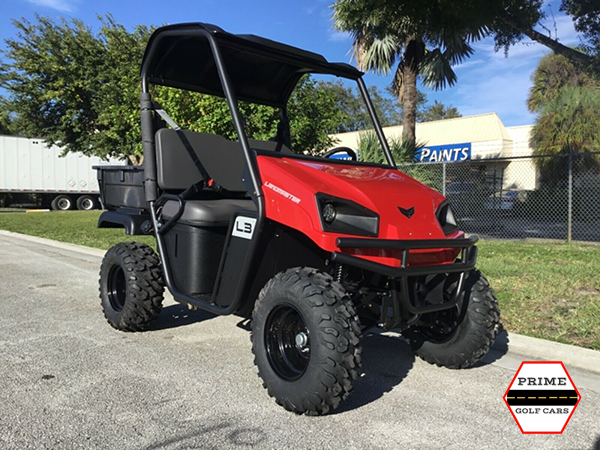
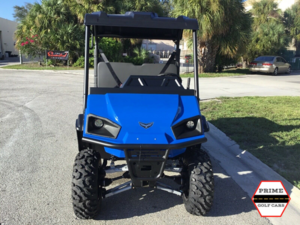 This cart has an all-steel frame – part of what makes it so durable and tough. With this, it’s protected from the inside out from rollover damage, and side skirts and fenders dampen motor and road noise, making the vehicle surprisingly quiet for a gas-powered utility vehicle. The LROSS and super-sport trailing arm also lessen the roughness of uneven terrain, such as railroad tracks, rumble strips, and off-road trails. A winch mount behind the bumper protects the winch from debris, and an in-dash connector for remote access.
This cart has an all-steel frame – part of what makes it so durable and tough. With this, it’s protected from the inside out from rollover damage, and side skirts and fenders dampen motor and road noise, making the vehicle surprisingly quiet for a gas-powered utility vehicle. The LROSS and super-sport trailing arm also lessen the roughness of uneven terrain, such as railroad tracks, rumble strips, and off-road trails. A winch mount behind the bumper protects the winch from debris, and an in-dash connector for remote access.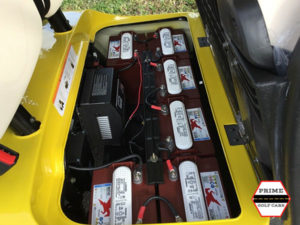
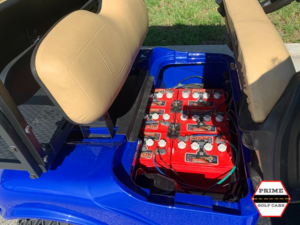
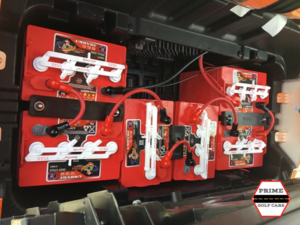
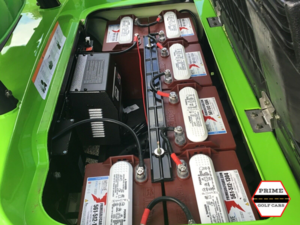

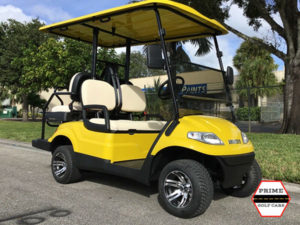 It depends on the golf cart! We sell a lot of street legal low speed vehicles (LSVs), such as our
It depends on the golf cart! We sell a lot of street legal low speed vehicles (LSVs), such as our  It depends on the condition of the golf cart. Most maintenance is not too complicated, and simple repairs such as battery replacements and tire changes can be done at home. The most important part of the golf cart to maintain and check regularly is the batteries. Standard lead-acid batteries can last around 3-6 years, depending on the type. Eventually, they will need to be replaced, but you can extend the life of the batteries by maintaining them regularly. Always make sure they have the right level of water – generally, they need to be refilled once a month, and you must use distilled water. You’ll also want to check for corrosion and loose terminals, and make sure the condition of the cables stays good. If you need to swap out a battery cable, they are generally inexpensive. Make sure to keep them charged. Other things to look out for include:
It depends on the condition of the golf cart. Most maintenance is not too complicated, and simple repairs such as battery replacements and tire changes can be done at home. The most important part of the golf cart to maintain and check regularly is the batteries. Standard lead-acid batteries can last around 3-6 years, depending on the type. Eventually, they will need to be replaced, but you can extend the life of the batteries by maintaining them regularly. Always make sure they have the right level of water – generally, they need to be refilled once a month, and you must use distilled water. You’ll also want to check for corrosion and loose terminals, and make sure the condition of the cables stays good. If you need to swap out a battery cable, they are generally inexpensive. Make sure to keep them charged. Other things to look out for include: Most of the time, golf carts are electric, but there are still gas golf carts being manufactured – we sell new
Most of the time, golf carts are electric, but there are still gas golf carts being manufactured – we sell new 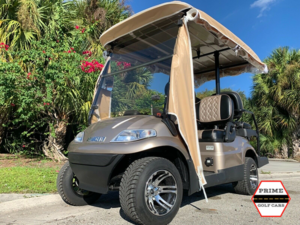 …get wet?
…get wet?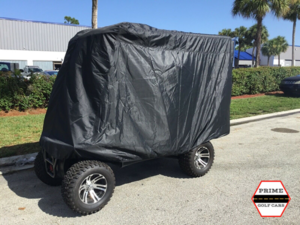 Yes, provided conditions aren’t too extreme. Golf carts are just like a car in the way that they can be parked outside and don’t necessarily need a garage, but it’s recommended to store them in a garage if temperatures get too hot or cold or heavy rainfall floods the area. If temperatures aren’t too severe or rain is a light to medium shower, you can store your golf cart outside and cover it with one of our
Yes, provided conditions aren’t too extreme. Golf carts are just like a car in the way that they can be parked outside and don’t necessarily need a garage, but it’s recommended to store them in a garage if temperatures get too hot or cold or heavy rainfall floods the area. If temperatures aren’t too severe or rain is a light to medium shower, you can store your golf cart outside and cover it with one of our 